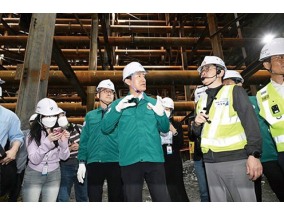 이미지 확대보기
이미지 확대보기Chairman Kim Byung-hwan met with bank presidents at the Bank Hall in Jung-gu, Seoul earlier in the day to discuss risk management for financial stability and ways to innovate the banking sector for sustainable growth.
In his remarks, Kim said, “Since the second quarter of this year, household debt has turned to an upward trend, mainly due to rising house prices in Seoul and expectations of interest rate cuts.” “We need to be alert to the increase in household debt from the first half of the year and proactively manage it together with the banking sector and the government,” he said. “We will implement the second-stage stress DSR from September 1, but we will increase the stress rate to 1.2 percentage points instead of 0.75 percentage points for mortgage loans from banks in Seoul and the capital region, which have been increasing in recent years.”
Stress DSR is a system that calculates the loan limit by imposing a certain level of additional interest rate (stress rate) when calculating DSR, taking into account the possibility that borrowers who use variable-rate loans may increase their burden of repaying principal and interest due to rising interest rates during the loan period. When stress rates are reflected, annual interest costs will increase, raising DSR and calculated loan limits will be lower than before.
In February this year, the government introduced a first-stage measure that applies 25 percent of the basic stress rate to bank mortgage loans. From the 1st of next month, the government will implement a second-stage measure that applies 50 percent of the stress rate to bank mortgage loans, credit loans and second-tier mortgage loans. From July next year, the stress rate will be 100 percent applied to household loans in the entire financial sector.
In February this year, the government introduced a first-stage measure that applies 25 percent of the basic stress rate to bank mortgage loans. From the 1st of next month, the government will implement a second-stage measure that applies 50 percent of the stress rate to bank mortgage loans, credit loans and second-tier mortgage loans. From July next year, the stress rate will be 100 percent applied to household loans in the entire financial sector.
The stress rate is determined by comparing the weighted average monthly household loan rate (published by the BOK) at the highest level in the past five years to the current rate. However, a minimum of 1.5 percentage points and a maximum of 3 percentage points will be applied to compensate for the tendency of over- or underestimation during the interest rate fluctuation period. Until the end of this month, the stress rate was 0.38% (rounded to the third decimal place), which is 25% of the 1.5% floor rate, but it will increase to 0.75%, which is 50%, starting next month.
Regarding the debt of small business owners, he ordered that the bank's support method needs to be systemized as a debt management that considers repayment ability, not a one-time one. Chairman Kim said, "The balance of small business loans in the first half of this year increased by about 380 trillion won compared to the end of 2019, before the outbreak of COVID-19, and although the government has taken measures such as extending maturity, deferring repayment and starting a new fund in cooperation with the financial sector, the debt of small business owners can affect not only the Korean economy but also the soundness of banks."
"In order to ease the burden of repayment tailored to small business owners, the role of the bank that knows the repayment conditions of borrowers is important," he said. "Let's come up with a plan to internalize the banking sector's approach to supporting small business owners into a system called Debt Management Considering the ability to repay loans" rather than one-time support."
On this day, bank presidents shared the current status of support for small business owners by each bank and promised to actively cooperate in supporting small business owners in the future. "Easing the difficulties of small business owners is our most urgent task today," said Cho Yong-byeong, chairman of the Korea Federation of Banks. "The bank is also working on this through the new start fund and win-win measures for each bank as well as the 2.1 trillion won + α program." "In the future, the bank will continue to cooperate with related organizations so that the comprehensive measures for small business owners announced by the government in July can work quickly on the spot," he said. "We will discuss with financial authorities how to ease the difficulties of small business owners and continue our efforts to restore the ecosystem of small business owners."
The banking sector has come up with a plan to support people's livelihood finance worth 2.1 trillion won + α and has been implementing it since February. 1.5 trillion won will be spent on interest refunds (cashbacks) for private businesses such as self-employed and small business owners, and the remaining 600 billion won will be used as autonomous programs for other vulnerable groups. By the end of last month, the banking sector refunded about 1.4544 trillion won, or 96.7 percent of the expected interest refund (1.5035 trillion won) paid by individual business owners. Support for small business owners and small businesses was executed at about 109.1 billion won as of the end of June.
Han Aran (aran@fntimes.com)
가장 핫한 경제 소식! 한국금융신문의 ‘추천뉴스’를 받아보세요~
데일리 금융경제뉴스 Copyright ⓒ 한국금융신문 & FNTIMES.com
저작권법에 의거 상업적 목적의 무단 전재, 복사, 배포 금지








![용산구 ‘나인원한남’ 88평, 9억 상승한 167억원에 거래 [일일 아파트 신고가]](https://cfnimage.commutil.kr/phpwas/restmb_setimgmake.php?pp=006&w=284&h=214&m=5&simg=2025071010042800278b372994c952115218260.jpg&nmt=18)










